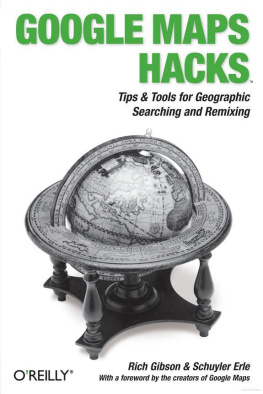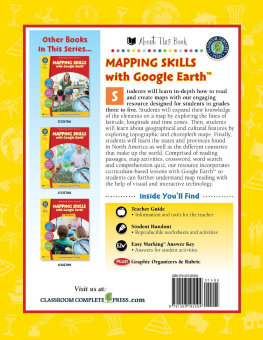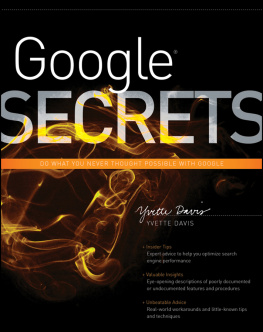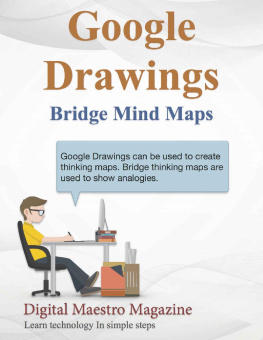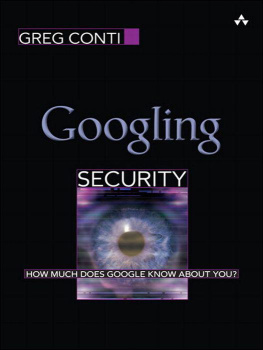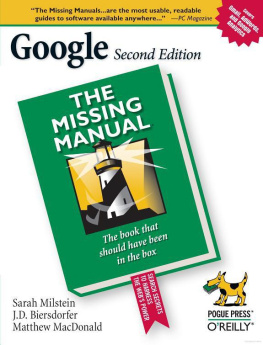Index
[]A9+Gmapsadding iconscustomizationadding mapscustomizationadding to mapsFlash appletsahding.comairport codesalgorithms forclustering markersautomatically cutting/naming custom map tilescustomizationautomatically using right onedeveloper's key (Google Maps API)avoidingtraffic jams
Index
[]bookmarkletsbookmarks
Index
[]calculatingdistancescell phonesCensus Bureau (U.S.)Chicagocitiescommunitiescontextcoordinates for latitude/longitudeCraigslistcreatingcollaborative photography maps of communitiescredit cardscrontabcustomizationadding icons
Index
[]developer's key (Google Maps API)documentation
Dedication
For Heather, Molly, Maddy, and Spencer, for everything .
Rich
For Jo, who knows .
Schuyler
Index
[]events
Index
[]FCC (Federal Communications Commission)filesFlash appletsFlickrfor public transportationroutesfullscreen mapscreating
Index
[]GeobloggersGeocoder.usstreet addressesgeotaggingGMaps siteGoogle EarthGoogle Mapping HacksGoogle Ride FinderGPS devicescoordinates for latitude/longitudeGxMagnifier
Index
[]horizontal/vertical panningHTML (Hypertext Markup Language)
Index
[]iconscustomIE (Internet Explorer)alternative, adding to maps
Index
[]JapanJavaScriptJavaScript libraryGoogle Maps API
Index
[]kilometers
Index
[]latitudelinksLinuxlocation searches
Index
[]Mac OS XMacromedia Flashmap tilesmapscreatingGPS track logs/waypoints, plotting ontrackingMicrosoft Windowsmilesmini-mapsmod_rewriteMozilla Firefox
Index
[]navigatingpublic transportationNorth AmericaNorth Americancitiesnuclear explosions
Index
[]of communitiesphotographsof Flickr photographslocation searchesoverlays
Index
[]performancePerlphotographson FlickrPHP (PHP Hypertext Preprocessor)plotting movements with Google Earthlinkspointsposting links to maps onweb sitesposting links to maps on web pagesGoogle Maps APIpublic transportation maps for cities inNorth Americapublic transportation routesmaps
Index
[]
Index
[]resizingroutesRuby scripting language
Index
[]serversstandardGPX (GPS Exchange Format)street addressescoordinates for latitude/longitudestructure ofURLs (Universal Resource Locators)subway stations
Index
[]
Index
[]telephone numbersTIGER/Line datatowersTPhototracking packagesUPStraffic jamstravelogue slideshows
Index
[]UPSUPS packagesmapsURLsLink to this page link (Google Maps)URLs (Universal Resource Locators)user-initiatedeventsusers
Index
[]verifying locations/directions
Index
[]waypointsweatherweb sites
Index
[]XML-RPC
Index
[]ZIP Codeszooming
Colophon
The tool on the cover of Google Maps Hacks is an antique globe of the earth. Unlike maps, globes allow for undistorted geographical representations of the earth and other spherical celestial bodies. The earliest known globe, the Nurnberg Terrestrial Globe, was made during the years 14901492 by German navigator and mapmaker Martin Behaim.
The cover image is from the "CMCD Everyday Objects" CD. The cover font is Adobe ITC Garamond. The text font is Linotype Birka; the heading font is Adobe Helvetica Neue Condensed; and the code font is LucasFont's TheSans Mono Condensed.
1.1. Hacks 19: Introduction
In February of 2005, Google quietly announced the debut of a new service, Google Maps, that changed the face of mapping and cartography on the Web for an overwhelming number of people. Gone were the tiny, slow-loading, and sometimes ugly digital maps that people were pretty much accustomed to using on the Web, maps that fell below the "fold" of a web page, and were often impossible to navigate. Instead, using the latest in web browser scripting technology, Google Maps offers a fast-loading, tiled map display, a simple yet deep user interface, asynchronous display updates in place of the tiresome click-and-reload routine, and, ultimately, even a rich scripting API. Although many of these features had been seen before in one place or another, no one had seen them all integrated with the attention to detail that we've come to expect from Google. Let's take our first look at how Google Maps changed how people use maps on the Web forever.
Hack 9. Use del.icio.us to Keep Up with Google Maps


Other people want to help you keep up with Google Maps (and anything else) !
What would you say to a world-wide community of people who spend a great deal of effort to maintain a chaotic but powerful set of links to most of the most interesting material that is available on the Web? How about "thank you" and welcome to http://del.icio.us/?
Quoting from http://del.icio.us/doc/about, Joshua Schacter created del.icio.us as a:
social bookmarks manager. It allows you to easily add sites you like to your personal collection of links, to categorize those sites with keywords, and to share your collection not only between your own browsers and machines, but also with others.
One key to the service is that your collection of links is intrinsically shared with others. So you can use del.icio.us to manage your own bookmarks, or you can just browse other people's links. Once you create an account by going to http://del.icio.us/register and picking a username and password, you can use the service to bookmark your own links.
A major part of the power of del.icio.us comes from the ability to tag your links. A tag is just a bit of text that you feel categorizes the link. shows a page of links that I tagged with the gmaps tag.
Figure 1-24. del.icio.us posts about Google Maps
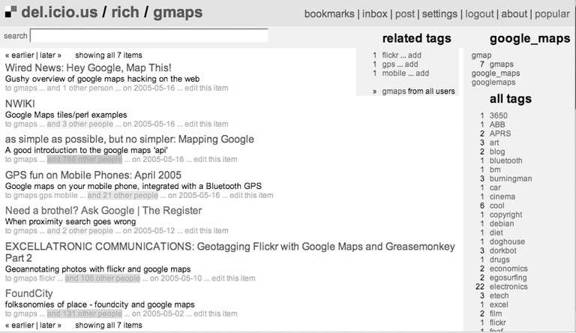
Since all bookmarks on del.ico.us are shared, you can look at other sites that people have tagged with the same tags. So if you wanted to see all of the sites tagged with gmaps , you can click on "gmaps from all users" or go directly to this url: http://del.icio.us/tag/gmaps. Or to see the sites tagged with gmap , try http://del.icio.us/tag/gmap. Other people use googlemaps and google_maps , so you can get to those with http://del.icio.us/tag/googlemaps and http://del.icio.us/tag/google_maps.
Once you've looked at other people's links, you will want to create your own. Joshua provided some nifty little . (There are a few different bookmarklets, so yours might look slightly different.)
Figure 1-25. Bookmarking a page in del.icio.us

When you click on the "post to del.icio.us" bookmarklet, it copies the URL and title from the current page and then pre-fills the "post to del.icio.us" form. You then can add an extended description and tags.
If you wish, you can totally ignore the rest of the world and use tags that are only meaningful to you. Or, you can strive to use a set of common and authoritative tags in all of your links.
Well, you could use that set of common and authoritative tags, except that no such thing exists, nor, really, is it capable of existing. The problem of classifying web pages is so difficult that it has driven otherwise brilliant people to near lunacy. And some of those folks were even Perl programmers!

